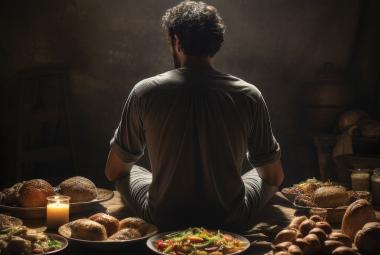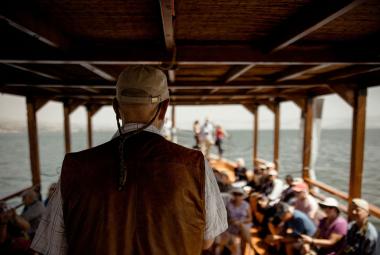The popular but shamefully blasphemous novel by Dan Brown, The Da Vinci Code, has raised many troubling questions, particularly among the less informed. Since Ron Howard is planning to bring it out as a major motion picture with Columbia next summer, this book will continue to be a popular topic of conversation, and it will continue to challenge many in their understanding of the Biblical texts.
Review
Dan Brown's fictional story opens with the murder of the curator of Paris' most famous museum, in which the victim leaves enigmatic clues in the form of codes that our hero, Robert Langdon, an expert on occult symbology, and Sofie Neveu, a professional cryptologist who joins him, must solve. Several of these clues involve hidden messages among the sketches and paintings of Leonardo da Vinci, from which the novel gets its name.
As the story develops, Langdon is viewed as the prime suspect, and the urgency of solving the increasingly complex sequence of subsequent codes, riddles, and clues becomes intensified. The hidden agenda of a secret order behind the fabled Knights Templar, and the sinister maneuvers of committed operatives of Opus Dei, an ostensible arm of the Roman Catholic Church, all weave a tapestry of intrigue and rapidly developing dangers.
What has ignited a serious controversy among uninformed readers is that this work of fiction poses as factual and constitutes a deliberate, blasphemous attack on Christianity, the Bible, and Jesus Christ Himself.
The Priory of Sion
The reader of Brown's book is immediately confronted with a preliminary page declaring: "FACT: The Priory of Sion - a European secret society founded in 1099 - is a real organization. In 1975 Paris's Bibliothque Nationale discovered parchments known as Les Dossiers Secrets, identifying numerous members of the Priory of Sion, including Sir Isaac Newton, Botticelli, Victor Hugo, and Leonardo da Vinci..."
It is this introductory presentation, which positions these "facts" as foundational truths, that compromises Brown's novel as simply a work of fiction and has caused confusion among so many.
It turns out that "the Priory of Sion" was organized in 1956, with Pierre Plantard as its Grand Master, an anti-Semite with a criminal record for fraud. Its background was, indeed, "proven" by a cache of documents that were "discovered" in the Bibliotheque Nationale in Paris.
However, they were planted there by Pierre Plantard himself! One of his henchmen admitted to assisting him in the fabrication of these materials, including the genealogical tables and lists of the Priory's grand masters. This hoax was exposed in a series of French books and a BBC documentary in 1996.
To claim membership of these famous persons is actually an assault on their respective memories and reputations. And Leonardo da Vinci's alleged involvement is, of course, fundamental to Brown's storyline.
The alleged mission of the "Priory" is the protection of a deep secret which, it is insisted, would jeopardize the entire Christian Church as we know it: that Jesus Christ was married to Mary Magdalene, and a daughter born to them was secreted off to (what is now) France and subsequently led to the Merovingian dynasty of kings.
The Knights Templar is presented as the military arm of the Priory of Sion, charged with protecting this bloodline and its attendant secrets. The "Holy Grail" (Graal, Old French for "cup") is, thus, not the legendary chalice, but a code name for this bloodline (Sang Real, "Holy Blood").
Many twists on the legends, fables, and controversies surrounding the Knights Templar are exploited to embroider Brown's tale and to support the blasphemous myth it promotes. (The many misstatements and distortions concerning this Brotherhood lie outside our purposes here and are incidental to the main themes of Brown's book.)
The Merovingians
The Merovingians were a dynasty of Frankish kings from the 5th to the 8th centuries. According to tradition, they descended from Merovech, chief of the Salian Franks, whose son was Childeric I and whose grandson was Clovis I, the founder of the Frankish monarchy, who died in A.D. 511. They are sometimes called "the first race of the kings of France."
The allegation that they descended from the union of Jesus and Mary Magdalene lacks any credible evidence whatsoever. However, there are those who claim their lineage links many of the major royal families of Europe and belief in these legends may lie behind some of the activism toward the "New Europe." (These fables were popularized by a book by Michael Baigent, Richard Leigh and Henry Lincoln, The Holy Blood and the Holy Grail, published in 1982.)
Opus Dei
Offsetting the intrigues of the Priory of Sion in Brown's novel are the machinations of Opus Dei. The "Prelature of the Holy Cross and Opus Dei" ("Work of God") was founded in Spain in 1928 by a 26-year-old Catholic priest, Josemaria Escriva, who died in 1975 and was canonized by Pope John Paul II in 2002. This organization helps its 80,000 recruited and indoctrinated members, and others, to a call to holiness by means of a rigorous daily routine, retreats, courses, and other undertakings. Fabulously wealthy and highly secretive, in Brown's novel the operatives of the Priory of Sion are subject to the intrigues - even assassinations - by ostensible operatives of Opus Dei, painted as a kind of "Vatican Mafia" for the purposes of Brown's plot tensions.
Magdalene Maligned
A spate of books has been published to catalog the numerous misstatements, distortions, and deliberate deceptions in Brown's book. But the primary offense - among many - is his trumpeting the Magdalene Heresy. This clearly is the central issue.
To add to the confusion, there are more than six Marys in the Scripture who are often misidentified:
- Mary the Mother of Jesus (deified by Catholics and virtually ignored by Protestants);1
- Mary, Mother of John Mark,2 prominent in the Jerusalem church, related to Barnabas,3 and owned a large home used for assembly;4
- Mary of Bethany, sister of Martha and Lazarus, contrasted with her sister Martha in her devotion5 and remembered for her memorial anointing.6 [Often also confused with a similar event in Galilee at a Pharisee's home also named Simon;7 the location, occasion, motivation, and atmosphere there seems distinct from the Bethany episode].
- Mary, Mother of James and Joseph,8 one of the group of Galilean women who supported Jesus financially9 and were present at the crucifixion, entombment, and witnessed the resurrection.
- Mary of Rome. Having served Paul and his party well elsewhere, moved to Rome;10
and, of course,
- Mary Magdalene, much maligned in both reputation and, here, ironically, in blasphemous libel. She was identified by her native city, Magdala, on the northwest shore of the Sea of Galilee. She was healed by Jesus of seven demons11 and was a person of means and a leader among the women.
However, in A.D. 591, Pope Gregory the Great gave an Easter sermon in which he erroneously declared that the prostitute of Luke 7 was Mary Magdalene of Luke 8. In 1969, The Vatican corrected centuries of misrepresentation by acknowledging that there was no basis for her identification as a prostitute.
Mary Magdalene is very visible in the Gospel record: She followed Jesus from Galilee, ministered to Him,12 beheld the crucifixion from afar,13 stood by the cross,14 located and watched the tomb,15 came early to the tomb with spices,16 was first to see the risen Lord,17 and reported the resurrection to the disciples.18
There is no basis to even suggest that Jesus was married, or that He had an "affair" with Mary Magdalene. This very notion demonstrates that the author has no concept of just Who Jesus is! Or what He was all about.
The Magdalene Heresy
Legends about Jesus and Mary Magdalene began to emerge in southern France during the 9th century, some even linking with the pagan goddess, Isis, etc. (Also, these were accompanied by myths about John the Baptist, whose successor was thought to be the Gnostic sex magician, Simon Magnus.19 )
Brown's novel attempts to support these outrageous notions by allusions from the Gnostic Gospels, in particular The Gospel of Philip. An out-of-context fragmentary reference to a kiss - in which Jesus kissed his other students as well - still suggests nothing about marriage or any sexual innuendos. Brown leans on a word in the "Aramaic" (although The Gospel of Philip came to us in Coptic) that he maintains means "spouse." The word happens to be a loan word from Greek, koinonia, which can mean companion, as in fellowship, etc.
The Gospel of Philip makes no reference that supports any of Brown's contentions. But even if it did, it would be irrelevant since it was written more than two centuries after the Gospel period, under a pseudonym posing as someone he wasn't. No serious scholar can take it seriously as having any historical merit.
But the reliance on The Gnostic Gospels, and twisted distortions of the early church councils, all raise serious questions: What makes us so confident that our Bible is what it purports to be? How do we know? What about these "missing" books of the Bible?
We will continue this series next month with a review of these "missing books," and some contemporary implications of the Magdalene Heresy and the associated Merovingian Myths, and their ostensible role in the unification of the New Europe today. We will also highlight some bizarre speculations regarding a 150 ft. statue of "Mary Magdalene" that graces an international port today. And we will also unveil the ultimate "code" that will be evident only to the most discerning reader! Stay tuned. "Film at eleven."
Notes:
- Cf. 2 John as John's personal letter to her!
- Acts 12:12.
- Colossians 4:10.
- Acts 12:12; mention of servants v.13.
- John 11, 12.
- John 12:3, Matthew 26:1-13; Mark 14:3-9.
- Luke 7:36-50.
- Matthew 27:56; 28:1; Mark 15:40,47.
- Mark 15:40; Luke 8:2,3.
- Romans 16:6.
- Mark 16:9; Luke 8:2.
- Matthew 27:56.
- Mark 15:40.
- John 19:25.
- Matthew 27:61.
- Mark 16:1, John 20:1.
- Mark 16:9.
- Luke 24:10, John 20:18.
- Acts 8:9-25.




